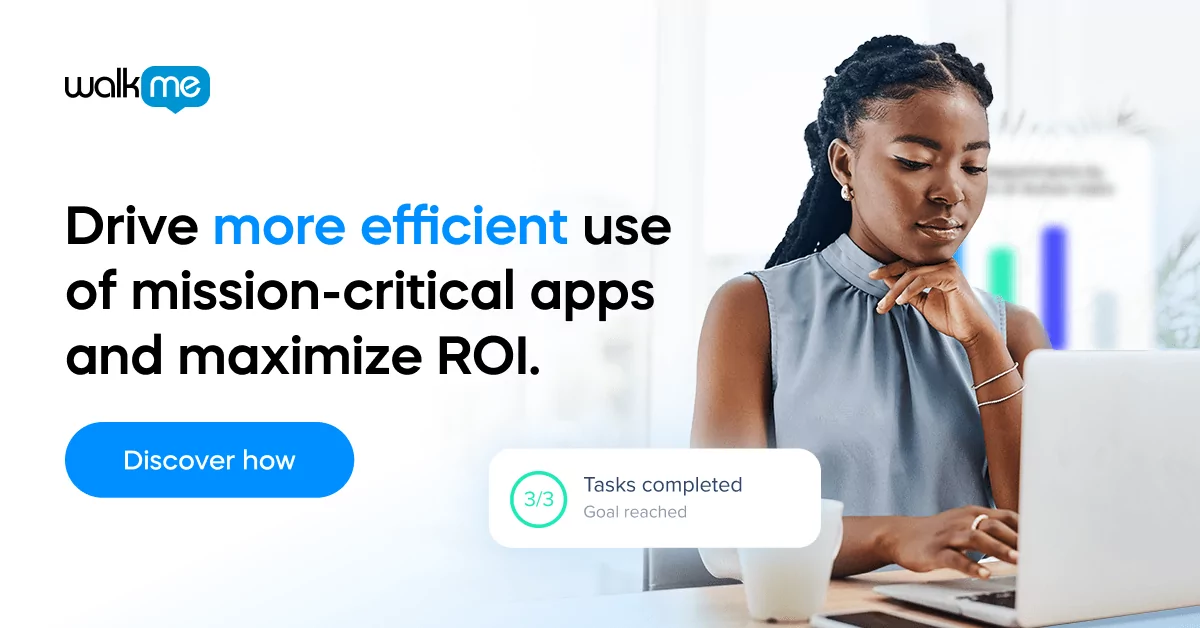When holistically looking at organizations, the period after COVID-19 will be telling in how companies prepare themselves for the future ahead.
The essence of business continuity planning has changed. Whereas before companies were bracing for temporary security breaches or even natural disasters, this pandemic set a new bar that is altering how individuals and organizations interact and work.
The term Next Normal was coined by McKinsey and refers to the period post-COVID-19. In a bid to flesh out what the Next Normal will mean for companies, WalkMe is researching and collecting data to better inform the business sector on how they can prepare for what is to come.
To that end, we have compiled a Next Normal checklist to guide CEOs and CIOs as they focus their energies on solidifying and strengthening their companies’ digital strategies.
Step 1: Maximize your workforce
In light of recent events, our dependency on technology has only increased. The way in which we use technology can be adapted to each user and employee. As workplaces become increasingly digital and remote work a more permanent fixture, employees will need to independently handle a suite of digital tools.
Digital dexterity
Digital dexterity is defined by Gartner as the ability and desire to exploit existing and emerging technologies for better business outcomes.
Organizations with employees who are digitally dexterous will have an easier time introducing new technology, and in turn, have staff embrace and acclimate to new digital initiatives.
HOW: Make digital dexterity a C-suite priority to create an inclusive organizational mindset and to close the gap created by digitization.
Reskilling & upskilling
Companies’ needs will shift as will roles. Smart leaders know that with the right training, a capable worker can be reskilled to change their current job function and switch positions within a company. Additionally, as organizations find their footing, workflows will also change. To keep up, employees will need to upskill and quickly ramp up on new processes or systems to best perform their current job.
HOW: The shift toward reskilling and upskilling your existing workforce means embracing digital learning at all levels to face the demands of a fast-changing business.
360° Productivity
Many companies drastically changed their working models and shifted to working from home. This was new to many, and 81% of companies worried about how virtual work would impact their employee productivity.
Suffice it to say, workspace flexibility will only increase moving forward. Organizations require a level of visibility and awareness to ensure their workforce is supported, no matter where they are physically located.
HOW: Access real-time data analytics to ensure employees are leveraging the tools they need to get the job done. Get visibility into where employees may be struggling and require increased training or clarity.

Step 2: Take care of your customers
Pre-pandemic, going digital was optional for some service-oriented organizations. Many saw success through a combination of traditional and digital means – think of your local bank that has an app but most customers physically come in for their banking needs.
COVID-19 cranked the lever to digital and to contact-free services. A clear line was drawn between service-oriented companies that accelerated their digital offerings and those that did not.
The standards have changed. Customers are now growing accustomed to digital solutions that provide them with quick and reliable service. Most customers find it easier to purchase virtually and expect their online experiences to be smooth and straightforward.
HOW: Rethink self-service by accelerating processes with automation and providing simplified help and support at the exact moment of need.
Step 3: Focus on digital adoption
As the dependency on software rises and overall budgets decrease, there will be an even greater need to be smart with technology purchases. CEOs and CIOs will have to discern what is essential to business.
The next step is to understand how said technology will be used. If employees or customers are confused and do not know how to complete tasks within a platform, then the technology investment has gone to waste.
70% of organizations today are focusing on measures to use their technology effectively and successful organizations will leverage this time to continue introducing new technologies with the right strategy in place.
HOW: Build digital resilience and up your digital strategy by embracing an adoption-first approach, which focuses on desired business outcomes.
Assess your digital strategy
Based on our current assessments, the Next Normal is an opportunity for digital acceleration. Companies are pushed by the current momentum to strategically evaluate their current digital strategy to maximize their workforce, take care of customers, and ensure digital adoption.


